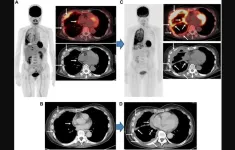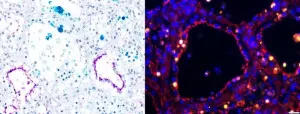(Press-News.org) Climate change is causing the ice masses in Greenland and Antarctica to melt. Water from the polar regions is flowing into the world’s oceans –and especially into the equatorial region. “This means that a shift in mass is taking place, and this is affecting the Earth’s rotation,” explains Benedikt Soja, Professor of Space Geodesy at the Department of Civil, Environmental and Geomatic Engineering at ETH Zurich.
“It’s like when a figure skater does a pirouette, first holding her arms close to her body and then stretching them out,” Soja says. The initially fast rotation becomes slower because the masses move away from the axis of rotation, increasing physical inertia. In physics, we speak of the law of conservation of angular momentum, and this same law also governs the Earth’s rotation. If the Earth turns more slowly, the days get longer. Climate change is therefore also altering the length of the day on Earth, albeit only minimally.
Supported by the US space agency NASA, the ETH researchers from Soja's group have published two new studies in the journals Nature Geoscience and Proceedings of the National Academy of Sciences (PNAS) on how climate change affects the polar motion and the length of the day.
Climate change surpasses the moon’s influence
In the PNAS study the ETH Zurich researchers show that climate change is also increasing the length of the day by a few milliseconds from its current 86,400 seconds. This is because water is flowing from the poles to lower latitudes and thus slowing down the speed of rotation.
Another cause of this slowdown is tidal friction, which is triggered by the moon. However, the new study comes to a surprising conclusion: if humans continue to emit more greenhouse gases and the Earth warms up accordingly, this would ultimately have a greater influence on the Earth’s rotational speed than the effect of the moon, which has determined the increase in the length of the day for billions of years. “We humans have a greater impact on our planet than we realise,” Soja concludes, “and this naturally places great responsibility on us for the future of our planet.”
The Earth's axis of rotation is shifting
However, shifts in mass on the Earth’s surface and in its interior caused by the melting ice not only change the Earth’s rotational speed and the length of day: as the researchers show in Nature Geoscience, they also alter the axis of rotation. This means that the points where the axis of rotation actually meets the Earth’s surface move. Researchers can observe this polar motion, which, over a longer timeframe, comes to some ten metres per hundred years. It’s not only the melting of the ice sheets that plays a role here, but also movements taking place in the Earth’s interior. Deep in the Earth’s mantle, where the rock becomes viscous due to high pressure, displacements occur over long periods of time. And there are also heat flows in the liquid metal of Earth’s outer core, which are responsible both generate the Earth’s magnetic field and lead to shifts in mass.
In the most comprehensive modelling to date, Soja and his team have now shown how polar motion results from the individual processes in the core, in the mantle and from the climate at the surface. Their study was recently published in the journal Nature Geoscience. “For the first time, we present a complete explanation for the causes of long-period polar motion,” says Mostafa Kiani Shahvandi, one of Soja’s doctoral students and lead author of the study. “In other words, we now know why and how the Earth’s axis of rotation moves relative to the Earth’s crust.”
One finding in particular stands out in their study in Nature Geoscience: that the processes on and in the Earth are interconnected and influence each other. “Climate change is causing the Earth’s axis of rotation to move, and it appears that the feedback from the conservation of angular momentum is also changing the dynamics of the Earth’s core,” Soja explains. Kiani Shahvandi adds: “Ongoing climate change could therefore even be affecting processes deep inside the Earth and have a greater reach than previously assumed.” However, there is little cause for concern, as these effects are minor and it’s unlikely that they pose a risk.
Physical laws combined with artificial intelligence
For their study on polar motion, the researchers used what are known as physics-informed neural networks. These are novel artificial intelligence (AI) methods in which researchers apply the laws and principles of physics to develop particularly powerful and reliable algorithms for machine learning. Kiani Shahvandi received support from Siddhartha Mishra, Professor of Mathematics at ETH Zurich, who in 2023 received ETH Zurich’s Rössler Prize, the university’s most highly endowed research award, and who is a specialist in this field.
The algorithms that Kiani Shahvandi developed have made it possible for the first time to record all the different effects on the Earth’s surface, in its mantle and in its core, and to model their possible interactions. The result of the calculations shows how the Earth’s rotational poles have moved since 1900. These model values are in excellent agreement with the real data provided by astronomical observations in the past and by satellites over the last thirty years, which means they also enable forecasts for the future.
Important for space travel
“Even if the Earth’s rotation is changing only slowly, this effect has to be taken into account when navigating in space – for example, when sending a space probe to land on another planet,” Soja says. Even a slight deviation of just one centimetre on Earth can grow to a deviation of hundreds of metres over the huge distances involved. “Otherwise, it won’t be possible to land in a specific crater on Mars,” he says.
END
How climate change is altering the Earth’s rotation
2024-07-15
ELSE PRESS RELEASES FROM THIS DATE:
Comparison of FDG-PET/CT and CT for treatment evaluation of patients with unresectable malignant pleural mesothelioma
2024-07-15
“FDG-PET is generally considered as a useful metabolic evaluation tool, while it is also thought to have an emerging role for assessment of systemic therapy response.”
BUFFALO, NY- July 15, 2024 – A new research paper was published in Oncotarget's Volume 15 on June 20, 2024, entitled, “Comparison of FDG-PET/CT and CT for evaluation of tumor response to nivolumab plus ipilimumab combination therapy and prognosis prediction in patients with unresectable malignant pleural mesothelioma.”
Malignant pleural mesothelioma (MPM) is an aggressive neoplasm and affected ...
New concept explains how tiny particles navigate water layers – with implications for marine conservation
2024-07-15
A new UBC study published recently in Proceedings of the National Academy of Science (PNAS) has unveiled insights into how microscopic organisms such as marine plankton move through water with different density layers.
Researchers Gwynn Elfring and Vaseem Shaik found that density layers, created by variations in temperature or salinity, influence the swimming direction and speed of tiny particles navigating a liquid.
Pushers and pullers
“There are two different types of microscopic swimmers – ...
New research shows a frictionless state can be achieved at macroscale
2024-07-15
UTICA, NY – The president of SUNY Polytechnic Institute (SUNY Poly), Dr. Winston “Wole” Soboyejo, and postdoctoral researcher, Dr. Tabiri Kwayie Asumadu, have published a revolutionary new paper titled, "Robust Macroscale Superlubricity on Carbon-Coated Metallic Surfaces." This paper explores an innovative approach to reducing friction on metallic surfaces – a significant advancement that could have major real-world impacts.
The study shows that superlubricity – a state with virtually no friction that was once believed to only be achievable at nanoscale – can now be maintained at macroscale for extended time ...
A novel and unique neural signature for depression revealed
2024-07-15
HOUSTON - (July 15, 2024) - As parents, teachers and pet owners can attest, rewards play a huge role in shaping behaviors in humans and animals. Rewards – whether as edible treats, gifts, words of appreciation or praise, fame or monetary benefits – act as positive reinforcement for the associated behavior. While this correlation between reward and future choice has been used as a well-established paradigm in neuroscience research for well over a century, not much is known about the neural process underlying it, namely how the brain encodes, ...
Academic psychiatry urged to collaborate with behavioral telehealth companies
2024-07-15
Waltham — July 15, 2024 — The strengths of academic psychiatry departments and the fast-growing private telehealth sector are complementary, according to a Perspective article published in Harvard Review of Psychiatry, part of the Lippincott portfolio from Wolters Kluwer. Justin A. Chen, MD, MPH, a psychiatrist at Weill Cornell Medicine in New York City, and colleagues reviewed literature on provision of outpatient mental health care in the United States. They concluded that academic psychiatry departments and telehealth companies could mutually benefit from strategic collaboration.
Academic medical centers struggle to ...
NASA’s Webb investigates eternal sunrises, sunsets on distant world
2024-07-15
Researchers using NASA’s James Webb Space Telescope have finally confirmed what models have previously predicted: An exoplanet has differences between its eternal morning and eternal evening atmosphere. WASP-39 b, a giant planet with a diameter 1.3 times greater than Jupiter, but similar mass to Saturn that orbits a star about 700 light-years away from Earth, is tidally locked to its parent star. This means it has a constant dayside and a constant nightside—one side of the planet is always exposed to its star, while the other is always shrouded in darkness.
Using Webb’s NIRSpec (Near-Infrared ...
Receptors make dairy cows a prime target for influenza, ISU team finds
2024-07-15
AMES, Iowa – As highly pathogenic avian influenza has spread in dairy herds across the U.S., the virus is being detected in raw milk. A new study by a broad team of researchers at Iowa State University’s College of Veterinary Medicine helps explain why.
Sialic acid, a sugar molecule found on the surface of some animal cells, acts as a receptor for influenza. Without sialic acid providing an entry point to attach, invade and infect, a flu virus is unlikely to find a potential host hospitable.
Before the recent HPAI outbreak ...
A new neural network makes decisions like a human would
2024-07-15
Humans make nearly 35,000 decisions every day, from whether it’s safe to cross the road to what to have for lunch. Every decision involves weighing the options, remembering similar past scenarios, and feeling reasonably confident about the right choice. What may seem like a snap decision actually comes from gathering evidence from the surrounding environment. And often the same person makes different decisions in the same scenarios at different times.
Neural networks do the opposite, making the same decisions each time. Now, Georgia Tech researchers in Associate Professor Dobromir Rahnev’s lab are ...
Wojtusiak to use artificial intelligence to help caregivers with social isolation
2024-07-15
Janusz Wojtusiak, Professor, Health Administration and Policy, College of Public Health, is set to receive funding for the project: “An Artificial Intelligence Solution to Social Isolation and Longlines of Caregivers of People with Dementia.”
Wojtusiak and his graduate student Ghaida Alsadah will lay the foundation for a large study aimed at utilizing AI methods to address social isolation and loneliness among people who care for those with Alzheimer’s Disease and those suffering from dementia.
Addressing ...
You're just a stick figure to this camera
2024-07-15
Images
A new camera could prevent companies from collecting embarrassing and identifiable photos and videos from devices like smart home cameras and robotic vacuums. It's called PrivacyLens and was made by University of Michigan engineers.
PrivacyLens uses both a standard video camera and a heat-sensing camera to spot people in images from their body temperature. The person's likeness is then completely replaced by a generic stick figure, whose movements mirror those of the person it stands in for. The accurately animated stick figure allows a device relying on the ...



